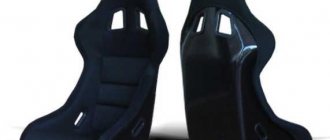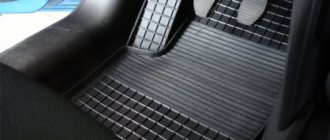Modern models of cars from the domestic concern VAZ are very popular among car enthusiasts. And the point is not only in their relatively low price, but also in decent technical characteristics and high maintainability.
Despite the appropriate characteristics, cars still have some weak points that vehicle owners have to work out on their own. One of these weak points is the car’s stove. In general, with high-quality assembly, the heating system works satisfactorily. However, there are significant shortcomings in the vehicle heating system, which provoke owners to improve and modernize it.
In this article we will look at how to cope with the problem when the VAZ-2110 stove blows poorly into the driver’s feet, which causes significant inconvenience for him.
Causes of poor-quality foot airflow
Almost all vehicle owners face the problem when the heater in the driver’s feet does not work on a VAZ-2110. The heating system on domestic cars has significant disadvantages - this is a weak air flow into the driver’s feet and towards the side windows. Often this situation occurs even during normal operation of the heater.
There may be several reasons why the stove is blowing weakly, and all of them are related to the technical design features of the heating system.
The first and main reason why the stove does not heat with the required intensity is poor-quality sealing of the heating system air ducts. The heater ducts are made of plastic and have a large number of slots around the perimeter. As a result, a significant amount of warm air is lost through the holes in the air ducts and a weak flow reaches the final destination.
The second element of the heating system, which requires improvement for better heating of the interior, is the plastic air distribution unit. People also call the driver his Christmas tree. This unit also has slots, which significantly reduces the flow of warm air to the driver's feet, side windows and to the rear seats of the vehicle.
The next detail that causes poor interior heating is the VAZ-2110 heater damper. Due to its design features, it does not fit tightly to the panel body. As a result, most of the hot air remains in the engine compartment and in the dashboard.
As you can see, the complex reason that the stove is blowing weakly is poor-quality sealing of the VAZ-2110 heater elements and the presence of a large number of cracks in the car’s heating system.
Before you begin to eliminate factory defects in the heater, you need to make sure that it is working properly. In case of problems with the functioning of the stove, it is important to first repair worn-out or damaged parts, and only then upgrade the heating system. Only in this case, modifications to the heating system of the vehicle will give a tangible positive result.
Which heating radiator to choose?
The main source of heat in the car interior is the radiator, which modern manufacturers produce from two materials - copper or brass, and aluminum. Which heater radiator is better - copper or aluminum for a VAZ 2110 - 2112 remains to be seen, since not only the efficiency of the heater, but also comfortable driving in winter depends on this choice.
Advantages of an aluminum radiator
To find out which heater radiator is better to install on the seven, let’s make a comparative comparison. To do this, you need to find out all the advantages and disadvantages of the two types of stove heat exchangers. First, let's figure out what the pros and cons of aluminum units that are installed on classics from the factory.
- Cost is one of the main advantages of such devices, since it is precisely because of the low price that many choose models made of aluminum alloy. The price difference between copper (brass) and aluminum devices can be up to two times.
- Large selection - these models are more popular, despite some of their disadvantages. The reason for this popularity is their price, but you often have to make sure that it is better to buy a copper unit for the stove. Among the advantages, heat transfer should also be noted, however, practice shows that heat transfer rates are significantly inferior to brass devices.
It is important to know: For “ten and twelve” manufacturers do not produce three-row heat exchangers made of aluminum, which actually causes low heat transfer. Only two-row ones are produced.
Advantages of copper heater radiators VAZ 2110 - 2112
Now let’s find out why a copper stove radiator is better than an aluminum one. The advantages of these units include:
- Thermal conductivity - even if we take into account the fact that copper ones are only called such, since they contain much more brass than copper, they have high thermal conductivity. It is this indicator that is fundamental when choosing a heat exchanger from which you can get more heat to heat the interior.
- Easy to repair - even the slightest mechanical damage can be repaired at home. Moreover, after soldering work, the unit can last a long period of time (which also depends on the quality of the soldering). The entire radiator is made entirely of plastic without the use of plastic.
- Not only are the plates made of copper, or rather a brass alloy, but the body itself is also made of a similar material. This is a big advantage, because due to this design, operational parameters are increased.
Three-row versions of radiators are produced. This brings more heat into the cabin. With so many advantages, one wonders if these devices have any disadvantages.
It is necessary to note some disadvantages of the copper heat exchangers under consideration. They also exist, and sometimes play a decisive role in choosing the appropriate units. The main disadvantage is the cost, which is 2 times higher than the price of aluminum analogues. It is precisely because of the big difference in price that most car owners give preference to aluminum competitors, having never experienced copper heater radiators on a VAZ 2110 - 2112
We recommend: Opel Astra H fuses and relays in a complete set
Options for improving the heating of the area around the driver's feet
To solve the problem of poor-quality heating of the driver’s feet, you need to start by improving the plastic air distribution unit. To do this, you need to completely dismantle and disassemble the car dashboard. After that, you can begin to seal the cracks. At the same time, sealing the holes will solve another important problem of the VAZ-2110 stove - poor-quality blowing of the side windows.
Most often, drivers use two methods to seal the elements of the heating system of a car: the first involves replacing the corrugated hose for air supply with a new product, the second involves gluing all elements of the heating system where there are holes.
It is best to use both methods in parallel. Anti-creak product is very suitable for eliminating holes. With its help, you need to glue all the existing holes around the perimeter of the parts for supplying air to the car interior. And at the same time it is necessary to seal and seal the cracks in the vehicle panel.
The next stage of work is the modernization of the heater damper. To do this, the valve is dismantled and the factory seal is removed, which copes very poorly with the assigned tasks. The heater damper and the places where it is attached to the car body must be treated with modelin or silicone to eliminate cracks. Next, instead of the standard sponge, you need to glue the bitoplast in several layers. This will help reduce the loss of warm air as much as possible and will accompany the supply of heat along the right path.
If all manipulations are carried out correctly and efficiently, the heat supply towards the driver’s feet will increase significantly. At the same time, experts advise using polyurethane foam to close the gap at the beginning of the air path to the driver’s side window. This will ensure high-quality heating of the side window, eliminate the problem of fogging or freezing, and increase the level of visibility for the driver.
Modification of the stove on a VAZ 2110 car
There is nothing perfect in the world. This becomes especially clear when it comes to modifying (upgrading) the stove on a VAZ 2110. No one wants to freeze in a car in winter, not to mention the windows covered with ice. Upgrading the VAZ 2110 stove becomes for motorists not just a momentary whim, but a cruel necessity dictated by the harsh Russian frosts.
Modification of the VAZ 2110 stove
In order to withstand the imperfections of the world in the form of the VAZ 2110 heating system, it will be enough to arm yourself with a tube of silicone or sealant, polyurethane foam, simple plumbing tools, and also a certain amount of patience. Without theoretical foundations, of course, there is no way either.
Modifying the stove, simple techniques
Modernizing the VAZ 2110-2112 stove is a thorough and multifaceted process. If you don’t have the time or opportunity to fully remodel the stove system, but you need a positive result in the shortest possible time and with minimal effort, because winter is almost upon us, you can try to listen to the following advice.
- 1. The easiest way to increase the air flow of the heater for heating the feet of the front seats in the cabin is by blocking the heater ducts for the rear ones. Any tool at your disposal will do. Thus, you sacrifice the comfort of your passengers, but is this really important if, for example, you prefer to drive alone;
- 2. A similar result can be achieved by blocking the air channels of the central deflector oven by cutting a suitable plug from a sheet of aluminum. Obviously, in this case, the heat flow directed to the side windows and other furnace ducts in the car increases.
Stove damper tens
- 3. Often, standard VAZ 2110 door seals are not enough for reliable sound and heat insulation. Simply gluing additional insulating tape around the perimeter (for example, from K-Flex) can significantly improve the comfort inside the VAZ interior with minimal time and money investments;
- 4. Replacing the 5-hole thermostat with a more modern 6-hole thermostat, which controls the engine cooling and heating system in VAZ cars. These thermostats are completely interchangeable, so there should be no problems. A 6-hole thermostat is technologically more advanced, and therefore the heating of the stove radiator in a car will be more efficient. Such pleasure costs about 350 rubles.
Refinement of the air duct system of the VAZ furnace, dismantling the standard installation
If you have a little time and desire, modifications to the VAZ 2110 stove can be done much more thoroughly, namely:
- sealing the cracks in the front panel of the torpedo air ducts;
- modernization of the car stove damper;
- modernization of the heating system for the rear seats and driver's feet, installation of corrugated heating ducts.
All this will certainly result in the desired result and significant heat transfer from the stove, but first you need to remove the dashboard along with the dashboard and heater air ducts, for which you need to:
- 1. Remove the floor tunnel lining cover and the interior heating air ducts of the VAZ 2110, and then the body itself, screwed with self-tapping screws to the bottom of your car;
- 2. To remove the instrument panel, you will first need to dismantle the glove box by unscrewing it from its hinges and turning off the glove box light;
- 3. Through the formed niche, unscrew the mounting bolts of the instrument panel;
- 4. Having unscrewed all the fastening screws of the panel in its upper and lower parts, as well as on the controller bracket, we can finally remove the instrument panel from the mounting studs;
- 5. In order to remove the panel from the car interior, you will need to disconnect the electrical connectors for connecting the devices.
Sealing the cracks in the front panel of the torpedo air ducts
The main problem with good blowing of side windows is the presence of a large number of cracks in the dashboard air duct system, which should only be sealed, thereby reducing heat loss and significantly increasing the pressure of the air flow for blowing the side windows of the car.
Heater duct routing
You will need silicone or anti-squeak (modelin). We seal around the perimeter all the cracks in the upper and lower parts of the torpedo panel. Also, do not forget to “silicone” all the mounting holes. At this point, you can consider the first stage of work completed.
Modernization of the VAZ stove damper
The problem with the stove damper is that the cracks in the housing are not properly sealed. As a result, regardless of the position of the damper, the flow of warm air is significantly lost, passing not where we would like it.
Furnace damper modernization
You can combat this by installing an additional seal (the same model and double-sided tape will serve you well). After removing the factory seal, completely glue the entire valve body, eliminating any gaps. You also tape the damper itself. Thus, you have significantly reduced losses in the air flow directed to the driver’s face, legs and windshield.
But to seal the gap at the beginning of the channel for blowing the driver's window, a conventional seal will not be enough. It is recommended to use polyurethane foam to reliably seal unwanted air channels, thereby eliminating significant losses.
Modernization of the heating system for rear seats and driver's feet in VAZ cars
Laying corrugated heating ducts
As for the module for distributing air flow to the driver’s feet, front seat passenger and rear part of the cabin, this also has its own factory flaws. They are also associated with insufficient sealing of cracks. You can fight with modelin or silicone, as in the case of a torpedo, if you do not want to disturb the factory aesthetics of the parts.
Airflow for rear passengers' feet
It would be much simpler and more reliable to cut off the ill-fated Christmas tree that distributes air flows and use three separate 40 mm corrugated pipes for heating ducts. What do you gain in this case:
- you get reliable sealing of the channels;
- three corrugated hoses take up much less space, which greatly simplifies access to the VAZ 2110 electrical wiring system, located there (there are really a lot of wires and access to them is extremely difficult).
Corrugation gasket for heater
We also remove the partitions of the old air distribution system. We seal the hoses using polyurethane foam. It should also be taken into account that the textured internal coating of a corrugated hose can cause whistling and howling of air, so we do not make the pipelines very large.
Refinement of the thermostat and its connection diagram
The previously discussed modernization of the VAZ 2110 stove by replacing a 5-hole thermostat with a 6-hole thermostat is not least related to the diameters of the bypass channels of the devices that regulate the flow of Antifreeze between the small cooling circuit and the radiator of the heating system.
Do-it-yourself modernization of air ducts of the VAZ-2110 heater
Very often, car owners do not stop at sealing the heater cracks to increase the level of warm air supply. Refinement of the air ducts that go from the air distribution unit to the driver’s feet, the front passenger’s feet and to the rear seats has a good effect on improving the heating of problem areas. The fact is that the plastic block has large gaps, and the quality of the air ducts also leaves much to be desired.
For modification, you will need polyurethane foam and three pieces of corrugation with a diameter of forty millimeters. When purchasing corrugated tubes, it is important to pay attention to their inner surface. It is desirable that it be smooth. In this case, when the stove is running, the whistle will not be heard inside the cabin. The modification involves dismantling the standard air distributor. Instead, new corrugated tubes are attached to the air supply holes using polyurethane foam, which are laid to the feet of the driver and front passenger, and the longest to the rear seats.
This modification will ensure a direct flow of warm air to the required purposes. The result will exceed absolutely all expectations. The flow of warm air without loss will flow efficiently both to the feet of the driver and to the feet of all passengers of the vehicle.
If the heater does not blow into the driver's feet, another effective method of increasing heating is to block the flow of warm air to the rear seats. However, this method is only suitable for those car owners who only in extremely rare cases carry rear passengers. To do this, it is necessary to completely block the central air duct using polystyrene foam or other material that can withstand high temperatures. In this way, you can ultimately achieve the strongest possible air flow to the feet of the driver and front passenger.
Let's sum it up
Minor factory deficiencies of the VAZ-2110 stove can be eliminated by almost every car owner without significant effort and serious investment. If the stove does not heat with the intensity required for complete comfort in the car interior, it is enough to carry out a high-quality modernization of the heater elements responsible for supplying warm air.
The problem when the heater in the area of the driver’s feet does not heat well can be eliminated by eliminating cracks in the air ducts, the heater valve, and the dashboard. Minor modifications to the heater air distribution unit and air ducts will significantly improve the quality of heat supply to the cabin. Thus, not only the problem of heating the driver’s feet is solved, but also complete, high-quality heating of the car interior is ensured, and the level of comfort will increase.
Why sometimes the stove on a VAZ 2110 does not heat well and how to fix it?
In the summer, as a rule, car owners do not think much about the operation of the heater, and only realize it if they already need to turn on the interior heating, and it turns out that the VAZ 2110 heater does not heat well, or even does not work at all.
The driver turns the control knob, sets it to the “hottest” position, but the stove works weakly, it’s cold in the cabin, the windows fog up and all this forces the native auto industry to “shut down.”
Heater device VAZ 2110
However, problems often arise due to the fact that the owner of the VAZ 2110 simply did not worry about the normal operation of the stove in time, and is now intensely asking the question: why does it heat poorly, and how to deal with it?
Types of additional heating device
If the owner of a Russian vehicle is thinking about how to install an additional heater on a VAZ-2110, then, first of all, he should know that the practical majority of currently existing designs fit directly into the standard cooling system of the power unit. The heated air flow is distributed throughout the cabin by a built-in electric fan.
An additional stove for the interior of the VAZ-2110 can be purchased at the store, however, in order to save money, such a unit can be made with your own hands. In fact, car dealerships sell completely different types of additional heaters. Depending on the budget and preferences of the motorist, you can choose both small and fairly large designs. True, not all presented models can be placed in the top ten without compromising passenger comfort. There is not much free space in a domestically produced car, so when choosing a unit, you should first decide on the location of its future installation.
If the car owner decides to install an additional heater under the passenger seat, then the purchased device should not be wider than 33 cm, higher than 20 cm and have a depth not exceeding 25 cm.
If you choose the optimal location for an additional heater, you should stop in the area of the car located between the seats (the unit will take the place of the tunnel), or directly under the front passenger seat.
In view of all the above conditions, the homemade additional heater VAZ-2110 must be an autonomous compact unit. Among the most popular models, it is worth noting the products of the TechnoMaster company, produced in Tolyatti. The cost of such a device ranges from 2500–3000 rubles. The products Helios, Xeros and Zenith, owned by the Eberspächer company, are of good quality. Their cost may be only a few hundred higher than the previously indicated models.
If the car owner decides not to waste time and not to upgrade the standard VAZ-2110 stove, but to place a new additional device in the cabin, when choosing a design, you should carefully study the characteristics and dimensions of the additional device.
Heating system design
The VAZ 2110's interior heating system has its own differences. First of all, it should be noted that the system works separately.
It is represented directly by the heater - a stove that prepares warm air entering the cabin through pipes - heat distributors. Air ducts lead into the cabin, where hot air flows directly from the control panel, and also blows on the windows or is directed to the driver and passenger's feet.
Control parts and air ducts of the VAZ 2110 stove
All this is controlled by a unit for regulating the air flow and its temperature (heating), that is, an air distributor. The VAZ 2110 stove has one more difference from others - it has an evaporator.
Disadvantages of the heater in the VAZ-2110
The main disadvantages, as a result of which car owners are forced to improve and modernize the heating unit:
- Weak air flow to the side mirrors and driver's feet. This problem often occurs during normal operation of the heating unit.
- Often consumers encounter a leak on a radiator device. The unit is equipped with a special tap, which wears out over time and begins to leak coolant. The faucet requires repair, but often the problem can only be solved by replacing the radiator assembly.
- The central air duct of the system includes two parts that are not sealed together. From the radiator device, this blower must supply a heat flow to the feet of the passengers sitting in the rear. If we take into account all the bends, then this is at least 2.5 meters. Of course, the heat flow does not reach the rear passengers.
Symptoms of a heater malfunction
The main signs by which you can identify problems with the heating unit:
- The temperature mode of the heater is not regulated. The problem usually lies in the control unit or in the operation of the heater dampers.
- The sensor located on the ceiling does not function. It is designed to determine the temperature inside the car.
- The heating unit does not function; only cold air flow is supplied to the vehicle interior.
- The side windows of the car or the feet of the driver and passengers are blown with hot air ineffectively.
- The volume of refrigerant in the cooling system decreases. The problem can manifest itself covertly or overtly. In the latter case, a leak can be noticed from the lines of the heating system or radiator device.
- The heating unit functions, but is very noisy.
The channel In Sandro's garage spoke in detail about replacing the electric motor of the heating unit on the "ten".
Temperature is not adjustable
There can be two reasons for such a malfunction: either the control unit malfunctions, or the damper does not work. First of all, check the temperature sensor (it is located on the ceiling near the ceiling lamp).
To do this, scroll the temperature control lever several times from the extreme “cold” position to the extreme “hot”. In addition, you can check the temperature simply by feeling.
Air temperature sensor in the cabin of VAZ 2110
If warm air begins to flow only when the sensor is set to the extreme “hot” position, it means that it is not working and needs to be changed.
Damper repair or replacement
It happens that the damper is “stuck” - that is, it stops turning due to the fact that the fastenings have oxidized and have not been looked at for a long time.
In the VAZ 2110, you can only “get close” to the damper from under the hood. First you need to remove the deflectors, then bend the antennae. Now try to move the flap by hand.
If it works and “walks” easily, then the reason is something else. But in any case, knowledgeable car enthusiasts recommend replacing the plastic damper with an aluminum one.
This small modification allows for better heat retention, the stove will work better, since, plus, there will be no deformation, which plastic dampers are prone to.
Damper micromotor
The micromotor for the damper drive is located under the hood near the windshield. You need to remove the frill and insulation to get to the motor. If the lever “moves” when the warm air supply is turned on, it means it’s working.
But it often happens that the gears wear out and “slip”, then it is better to replace this motor. Some craftsmen open the damper manually, without this motor, and they drive like that.
However, in this case, hot air will constantly be blown out, that is, such a “repair” is only possible as a temporary measure.
Modification of damper and airflow
Many drivers may have encountered the problem that in very cold weather there is no way to regulate the uniform supply of warm air in all directions. So it turns out that either the side windows are covered with ice, or the legs freeze. For example, if the VAZ-21103 stove does not heat well, then the problem is obviously in the dampers. So, on vehicles that were produced after 2003, there is no such problem, but on those that came off the assembly line before, you will have to work with this. There is nothing complicated here; you will need to cut out the edges of the damper with a regular metal file (you don’t need to touch the windshield damper). You can also saw off a little bit from the flap that supplies air to the side windows. As a result, if you put the damper on the legs, then approximately 50% will go to the side windows, 25% to the legs, and another 25% to the windshield. If you install it on the windshield, it will blow only on it.
Another reason why the VAZ-21103 stove does not heat well is that the airflow is insufficient. Let's finalize it. For this you will need anthers, as well as a grille. Using an elastic band, we attach the grille to the boot, for which we use any suitable glue. We secure the boot on the reverse side with a clamp or tie and enjoy the result. This solution is not suitable for the driver’s seat, as it will heat up the right leg, but it’s perfect for passengers. Well, now let's move on, because we still have a lot to consider.
Leaking radiator
It is possible that the heater on the VAZ 2110 is not working well due to a leak in the radiator. You add antifreeze, which may help for a while, but then the stove starts acting up again. Why is this happening?
Check the radiator for integrity. This is one of the most difficult tasks regarding the heating system, since in order to get to the radiator, the stove must also be removed.
If the radiator is bad, then it is better to replace it rather than try to solder it. This may not last long, but there is a lot of hassle with disassembly and assembly.
Insulation
Sometimes hot air does not flow well to the feet and side windows. Although the stove works fine, for some reason my feet are cold, and the side windows are foggy. Even if you install a new corrugation, it is unlikely to help much.
It is also necessary to eliminate all the cracks so that the warm air does not fight with the cold air, but goes straight to the target. Everything on the panel needs to be sealed with anti-squeak, and in some places with polyurethane foam, which will not creak and will also help retain heat for a while.
The VAZ 2110 stove does not heat well: causes and their elimination. How to remake a VAZ 2110 stove?
Problems with a poorly functioning heater occur not only on domestic “classics”, but also on more modern cars. VAZ-2110 is no exception. In practice, it turns out that in the summer, if you turn on the stove, it will be very hot, but in the winter, on the contrary, there is minimal use from it. However, it is difficult to say why this happens, so it is necessary to consider several relevant reasons and try to eliminate them. Let's figure out why the VAZ-2110 stove does not heat well and how to deal with it.
A little about the design
The VAZ-2110 model, which is as close as possible to European cars, has many flaws, especially with regard to the heater. In our case, it is separate and consists of several elements. The first one is the heater, it is located under the hood. Its task is to prepare the air that will be supplied to the cabin. This refers to speed and temperature. The second element is located in the cabin, and this is the air distributor. If your VAZ-2110 stove (16 valves) does not heat well, then the first thing you need to do is understand which of the two units is not working correctly. Everything is quite simple here. Now you will understand why exactly.
Design Features
For the VAZ 2110, it is possible to install two types of stoves - new and old. Regardless of the engine used (injection or carburetor), there are no fundamental differences in the designs of the stoves.
But what is the difference between the new and old type stoves? Let's try to figure it out.
- Radiator design. This is the main difference between the devices. Therefore, when replacing a radiator from an old one to a new one, be sure to take into account the installation nuances;
- The controller knob on stoves is slightly different. Old-style heaters have a main problem - they have been discontinued. They cannot be an analogue for 4 and 5 position controllers, which began to be equipped with dozens of them in the fall of 2003;
- The micro-gear motors for the stoves are different, starting in September of the same 2003. The difference lies in the shaft position sensors (resistors). Therefore, when making repairs, make sure that the devices are truly interchangeable and that you bought old-style resistors for your old stove, not new ones. Otherwise the gearmotor will not work.
We recommend: Instructions on how to turn on the air conditioning on opel astra and zafira, possible difficulties











